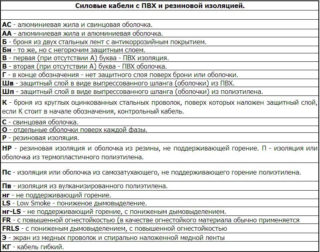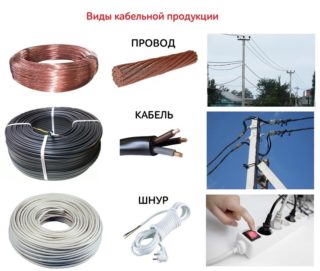Often, consumers who have not received special knowledge of electrical engineering are faced with laying the electrical network or repairing devices. Household conductors have similar external characteristics and markings, so it is not easy for users to determine how a cable differs from a wire or cord according to GOST 22483-2012 and TU manufacturers. You should understand the terminology and get reliable information.
Difference between cable and wire
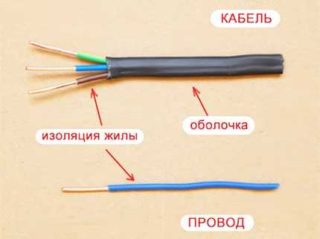
A cable is a plastic or rubber line that contains several insulated conductors inside. Conductors are combined into a single system for ease of installation and operation, protection from external influences. The special cable can be easily distinguished by the presence of an armored casing that prevents damage during mechanical action.
The wire is a stranded or single-core carrier, equipped with light tubular insulation or represented by a hollow metal rod with a conductor cross-section of 1.5 mm or more.
The differences between cables and wires are in the number of cores, type of insulation, marking and purpose. Due to the double insulation of the current-carrying cores, the cable passes large currents and voltages relative to the wire. The difference is hundreds of kilovolts in favor of the cable.
Outer shell
According to GOST 15845-80, a wire is one conductor, a cable is two or more insulated conductors combined in additional insulation. If two or more metal rods lack a protective sheath, it is classified as a wire.
Decoding values
Wire names contain the following meanings:
- the letter “A” in front indicates that it is an aluminum wire;
- "P" - copper wire;
- "PP" - 2 or 3 flat copper conductors;
- the following values: "P" - polyethylene insulation, "R" - rubber, "V" - vinyl, "L" - cotton braid;
- "N" - additional protection with non-combustible nairite, "B" - vinyl;
- "Г" - the letter makes the difference in marking, thanks to the flexible current-carrying core;
- "TO" - anti-rotting coating.
The numbers in the code indicate the cross-section of the wires.
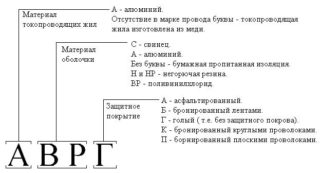
When marking cables with GOST, the following procedure is established:
- Core type. "A" - aluminum, lack of letter - copper.
- Appointment. "K" - control, "KG" - with increased flexibility.
- Protection. "P" - polyethylene, "V" - vinyl, "R" - rubber, "NG" - non-flammable and "F" - fluorlon cover.
- Reservation or outer cover. "A" - aluminum, "C" - lead, "P" - polymer, "B" - vinyl, "P" - rubber, "O" - coating of all phases, "Pv" - vulcanized plastic.
- Protection. "B" - anti-corrosion armor, "Bn" - non-combustible armor, "2g" - double PVC tape, "Shv" - vinyl hose, "Shp" - polymer hose, "Shps" - self-extinguishing polymer hose.
Scope of use
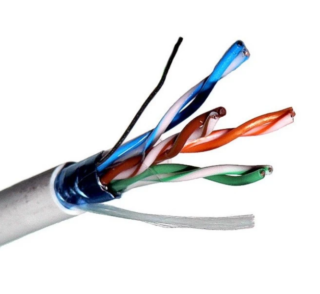
Reliable protection against mechanical and aggressive action, extended service life, rated voltage are the main features of the cable, which should be distinguished from the wire when installed in special conditions. Powerful insulated systems are suitable for laying the power grid under water, ground, in mines, areas of high fire hazard, corrosive activity.
According to the PUE (electrical installation rules), the cable is divided into 5 categories:
- Power ones are designed for the transmission of electricity, are laid stationary or when connecting mobile consumers.
- Hook-up wires are used for inter-device routing of devices. They cope well with elevated temperatures and 500 V.
- Communication devices are found in signaling and wired communication systems.
- Control lines are well recommended when connecting control and lighting circuits in electrical equipment with a voltage of 600 V.
- RF and optical media transmit energy and signals at specified radio frequencies or in the optical range.
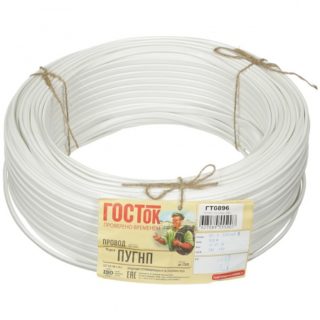
According to the field of application, the wires are classified into assembly, power, installation groups. The former are used for flexible or fixed wiring in switchboards, radio and electronics manufacturing. Power options are part of power grids, installation wires are applicable when connecting installations, power transmission systems inside, outside buildings.
- For stationary laying in closed rooms, wires are suitable - PUGNP, PUNP, APUNP, PVS.
- Installation and assembly products - PV-1, PV-3, APV, MKESh - are laid in pipes, building voids, cable trays and under the plaster.
- In places requiring increased heat resistance, PNSV wires are applicable.
- For overhead lines, SIP-2, SIP-3, SIP-4 are suitable
- Low-current communication - PRPPM, TPPep, TRP.
The classification of electrical conductors is detailed in the ISO 11801 2002 standard.
Life time
The average service life of a cable is 30 years, wires - from 6 to 15 years. The duration of operation is due to the presence / absence of two or more insulation, armored shell.
The difference between a cable and a cord
A flat shape and a minimum cross-section of conductors (1.5 mm2), use in household electrical wiring are the main indicators that allow you to determine how the cords differ from cables and wires. Multi-core options are more common, however, for electrical appliances that do not require special grounding, two-core cords are quite suitable.
Insulation
The flexible cores of the cord are covered with polymer insulation and enclosed in one protective casing made of soft plastic or rubber.
The electrical cable consists of several wires protected by general insulation (PVC, rubber, plastic). Depending on the area of application, many manufacturers tend to complete the cable with reinforced protective covers, and the wire or cord is hidden under a light sheath.
Only the cable can have additional armor of lead, aluminum or steel wire / tape specified in the marking.
Marking
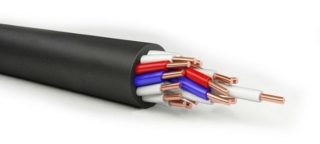
Depending on the purpose and type of insulation in electrical engineering, the following cable markings are found:
- Power options in PVC insulation - NYM, AVVG, VVG.
- Flexible conductors in a rubber casing - KG.
- Control cables - KVVG.
- Power armored products - AVBShv, VBbShvng.
- Information and radio frequency - FTP, UTP, RG, SAT, RK, KVK-V, KVK-P.
- Firefighters, signaling products: KPSng, KPSEng, KSVV, KSPV, KTSPPEP.
- Heat-resistant - RKGM.
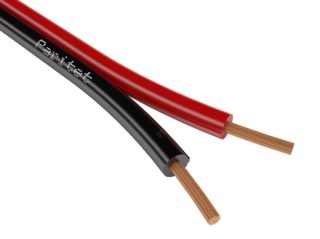
Among the common brands of cords are: SHVP, SHVVP, SHTLP. The first option is suitable for connecting electronic equipment, apartment lamps and climatic equipment (fans, ionizers), subject to slight mechanical deformations.
ШВВП is a multicore cord with stranded copper conductors insulated with PVC-plastic. The vinyl sheath prevents the spread of fire when ignited.
SHTLP - telephone conductor.Linear cord, contains stranded copper conductors in polyethylene film with PVC insulation.
Terms of use

The softness and flexibility of the cord determines its widespread use in everyday life, when connecting household appliances. For fixed installation, monolithic cables (power, control, control and communication, radio frequency) are preferred.
Life time
Cable life depends on specifications and operating conditions. For example, power-type products have been used for 30 years at a temperature of -50 ... + 50 ° C. The control cable when laid outdoors and in trenches has been working for more than 15 years, in rooms, tunnels, channels - 25 years. The ballscrew cord will last a maximum of 6 years under normal conditions.
The constant operating voltage for the cable varies in the range of 25-70 kV and more, for the cord - 380 V.
Choosing between cable and wire
The choice between cable, cord and wire depends on the operating conditions and the characteristics of the system. For example, it is unprofitable to purchase a cable for connections with low power, it is better to give preference to 2 wires woven together. Knowledge of the differences between electronic carriers increases the likelihood of rational use of material and protection systems, ensuring the safety of the electrical system.

